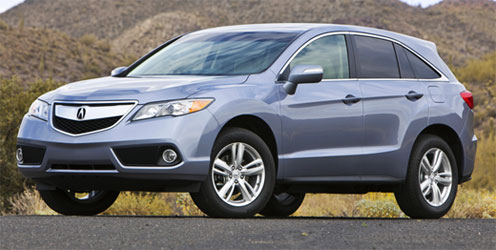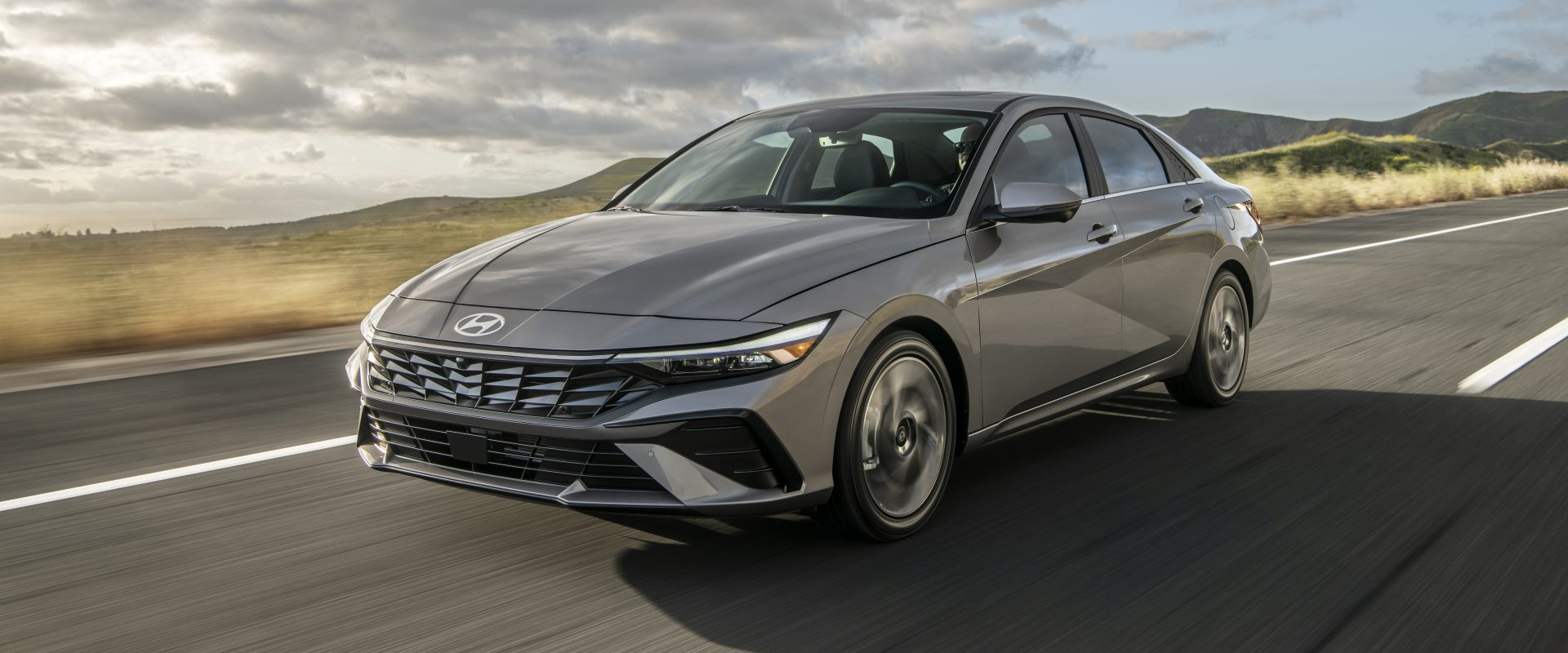2013 Acura RDX
The 2007 Acura RDX was hailed as the “urban running” back of compact crossovers. With turbo-4 power and super-handling all-wheel-drive it looked primed to blast through the competition. But, as it turns out, most compact luxury crossover pretenders aren’t looking for overboard performance; they just want room for their stuff, a few high end features to brag about, and enough traction for the occasional snow day. So, let’s see if the re-purposed Acura RDX does any better with this new mission.
Originally developed for young, hot-shot couples who were looking for a jazzy luxury crossover to make quick getaways out of the city, the 2013 Acura RDX has been redesigned more for the “been-there done-that” crowd, who want refinement and all-weather security in a compact but versatile package. And we can certainly feel that the new RDX is more refined. The MacPherson strut front suspension and trailing arm multi-link rear have been re-engineered, now with an emphasis more on ride comfort rather than handling performance.
Still, new Amplitude Reactive dampers feature an integrated rebound spring that helps maintain most of the previous models cornering capabilities. Power too takes a step upscale by substituting a corporate single-cam 3.5-liter V6. Horsepower is up 33 over the previous Turbo-4 to 273, and torque rates 251 lb-ft. The familiar six includes Variable Cylinder Management while the automatic transmission gains a sixth gear. Both gelling to make Government Fuel Economy Ratings actually better than the 4-cylinder at 19-City, 27-Highway, and 22-Combined for our all-wheel-drive model. We averaged an impressive 26.1 miles-per-gallon of Premium fuel in mixed driving. The Energy Impact Score is also much improved burning through 15.0-barrels of oil per year while emitting 6.7-tons of CO2.
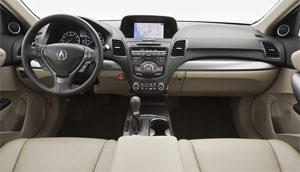 The all-wheel-drive system itself is less refined however. Gone is Acura’s torque shifting super-handling all-wheel-drive where up to 70 percent of power could switch to the rear wheels. The new RDX uses the Honda CR-V’s Intelligent Control on-demand system. So, while you won’t get much help in switchbacks, up to half the power can find its way to the back for able traction in slush and snow.
The all-wheel-drive system itself is less refined however. Gone is Acura’s torque shifting super-handling all-wheel-drive where up to 70 percent of power could switch to the rear wheels. The new RDX uses the Honda CR-V’s Intelligent Control on-demand system. So, while you won’t get much help in switchbacks, up to half the power can find its way to the back for able traction in slush and snow.
Refinement continues inside as the new cockpit has a genuine premium feel, trading a sporty edge for the more typical blend of Acura high-tech modern luxury. The leather upholstery looks both inviting and durable. But just when you start appreciating new features like standard 10-way power driver’s seat with heat, and push-button start; you also begin noticing cost cutting measures like only 4-way power for the front passenger and getting GPS navigation requires adding a costly Tech. package.
The NAV system is the typical Acura setup, and while we like the position of the central controller, we find that many times it just takes too many click-throughs to get to what you want. With just about everyone else going touch-screen why can’t Acura? Still, it’s hard to consider the RDX an entry-level model, as it is clearly a big step up over Acura’s other entry-level offering, the ILX sedan.
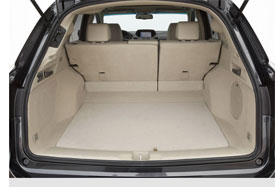 It’s also hard to pigeonhole the RDX as a compact crossover either, as it offers interior room and an overall feel that’s more mid-size. That’s despite a small towing capacity of just 1,500-pounds. The rear seat is roomy for its size, however, and seat backs fold easily with the pull of a lever, though not completely flat. Still, seat up cargo room is almost best in class at 26.1 cubic-ft, and 61.3 with them folded.
It’s also hard to pigeonhole the RDX as a compact crossover either, as it offers interior room and an overall feel that’s more mid-size. That’s despite a small towing capacity of just 1,500-pounds. The rear seat is roomy for its size, however, and seat backs fold easily with the pull of a lever, though not completely flat. Still, seat up cargo room is almost best in class at 26.1 cubic-ft, and 61.3 with them folded.
If we have one complaint it’s that the new RDX doesn’t really seem to have a sparkling personality. It looks very nice, inside and out, especially with its more subdued shield grille; but a bit sterile overall, and perhaps now too similar to a lot of other compact crossovers including Honda’s own CR-V.
At our test track, the RDX’s electric-assist power steering felt great, and diving through the cones was easier than we were expecting given the absence of super-handling all-wheel-drive. Front end reaction is direct and turn-ins sharp, while body roll is moderate. Streaking down the quarter-mile, the RDX is smooth and quiet as it hits 95-miles per hour in 15.4-seconds. Sprints to 60 take just 7.0-seconds, thanks to a nice, firm launch and quick-building power. Panic stops from 60 averaged just 126-feet, with good pedal feel and consistency throughout our tests. So, maybe the RDX hasn’t lost all of its athletic pretense after all.
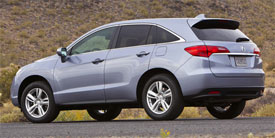 But, as it is more refined and better equipped, its price has also moved a bit upscale. Base sticker jumps about 4 percent to $35,215. Adding all-wheel-drive is another $1,400, and going all in with the Tech. Package will take you to $40,315. The 2013 Acura RDX succeeds in its new mission of providing high tech luxury and four-season traction in a smaller but still ample sized package. And, it is truly a nice vehicle; it’s just no longer a stand out. The first RDX took a pretty unique approach. The new RDX is more of a consensus response. Still, that’s what small luxury crossover buyers seem to want, and the new RDX is a fine answer for their cravings.
But, as it is more refined and better equipped, its price has also moved a bit upscale. Base sticker jumps about 4 percent to $35,215. Adding all-wheel-drive is another $1,400, and going all in with the Tech. Package will take you to $40,315. The 2013 Acura RDX succeeds in its new mission of providing high tech luxury and four-season traction in a smaller but still ample sized package. And, it is truly a nice vehicle; it’s just no longer a stand out. The first RDX took a pretty unique approach. The new RDX is more of a consensus response. Still, that’s what small luxury crossover buyers seem to want, and the new RDX is a fine answer for their cravings.
Specifications
- Engine: 3.5-liter V6
- Horsepower: 273
- Torque: 251 lb-ft.
- 0-60 mph: 7.0 seconds
- 1/4 mile: 15.4 seconds @ 95 mph
- EPA: 19 mpg city/ 27 mpg highway
- Energy Impact: 15.0 barrels of oil/yr
- CO2 Emissions: 6.7 tons/yr
2024 Hyundai Elantra
Basic Transportation At Its Best…And That Is A Compliment
For those of you who write in every week bemoaning the fact that all we seem to do around here is test incredibly expensive cars and EVs that only the very well to do can afford, this one’s for you. It’s a commuter and budget friendly mainstay from Hyundai, the compact Elantra sedan. And, it has been nicely updated for 2024.
We clearly do enjoy driving high-performance machines and ultra-luxury rides around here, but like most of you, when it comes time to drive home at the end of a long workday, we do so in something much more practical and affordable, like this 2024 Hyundai Elantra sedan.
If you’re thinking the front end has gotten more aggressive, you’re right. Hyundai calls it a “Shark Nose” theme, and we’re guessing they were thinking more Great White than Hammerhead, though Megamouth shark would also apply. It helps for a low and wide look; more substantial than the typical compact. Other additions for ’24 include slimmer daytime running lights, revised stainless steel Hyundai emblem, reshaped front fenders, sport sedan-style rear diffuser with silver trim; a parametric pattern added to the C-Pillar, and new LED taillights that take up a lot more space on the highly sculpted decklid. Plus, new wheel designs in sizes ranging from 15- to 18-inches.
Standard engine in SE, SEL, and Limited grades is this naturally aspirated 2.0-liter I4 with 147 horsepower and 132 lb-ft of torque. Even with no hybrid assistance, it gets substantial Government Fuel Economy Ratings of 31 City, 40 Highway, and 34 Combined; we averaged a great 38.6 mpg of Regular.
Those high fuel economy numbers mean acceleration times are pretty high as well. It was in no particular hurry to get off the line at our test track, as after a slight jolt of power, it felt pretty sluggish going down the track, taking us a lengthy 9.4 seconds to hit 60 mph. Hyundai’s Intelligent Variable Transmission has some realistic simulated gear shifts built in, and they not only provided the feel of a true automatic, but kept engine noise from becoming overbearing. And while this 2.0-liter may not be a house-on-fire off the line, it has no problem keeping up with traffic, and feels like just the perfect amount of power for a practical and safe commuter car.
There are other engine options too. Two choices if you want to go faster, a 1.6-liter turbo with 201 horsepower in the Elantra N Line, and a 276-horsepower turbocharged 2.0-liter for the Elantra N; plus, one with even better fuel economy, a 1.6-liter hybrid with a 139 horsepower total output.
And despite some significant understeer, there was good feel through the cones of our handling course, both in steering and chassis feedback. We wouldn’t quite call it “point and shoot,” but it responded to inputs fairly quickly, with only moderate body roll. All-in-all, when it comes to performance, it doesn’t claim to bring a whole lot to the table, but does clearly overachieve with what it does bring.
And Hyundai is always overachieving when it comes to packing in features, yet has found a way of keeping things refreshingly simple with a good mix of touchscreen and manual controls. Lots of space too, both up front in the surprisingly wide front buckets, and in the rear bench with ample room for three. Updates for all Elantra interiors include softer materials on the door panels, upgraded instrumentation and additional charging ports, plus a surround view monitor and new H-Tex simulated leather for Limited trim.
Elantra pricing starts with an SE at $22,775, the SEL comes in at $24,725, Limited begins at $28,215, and the sporty N Line starts at $29,615. If you’re interested in the hybrid, base Blue starts at $27,400 with Limited at $30,600.
Some might say there’s not a whole lot that’s earth shaking about the 2024 Hyundai Elantra, but that’s mostly why we like it so much. When it comes to just delivering good, basic transportation with a high dose of unexpected amenities, Hyundai delivers once again.
Specifications
- Engine: 2.0-liter I4
- Horsepower: 147
- 0-60 mph: 9.4 seconds
- 60-0 Braking: 111 ft (avg)
- MW Fuel Economy: 38.6 MPG (Regular)
- Transmission: IVT
- Torque: 132 lb-ft
- 1/4 Mile: N/A (Track Maintenance)
- EPA: 31 City / 40 Highway / 34 Combined




